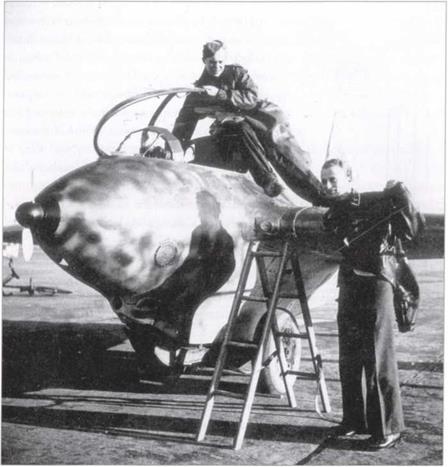Midget Aircraft. And Local Fighters
|
L |
ocally based fighters stationed to protect sensitive areas and able to reach operational heights swiftly by rocket power were seen at the beginning of 1944 as one way forward against day-bomber formations. The first such machine introduced by the Luftwaffe was the Me 163 Komet. The first fighter unit to be so equipped was JGr 400 at Wittmundhafen. The initial contact with enemy four-engined bombers occurred on 14 May 1944 over northern Germany when Me 163 В V-41 approached a bomber at 960 km/hr (595 mph) but turned away with a technical problem. When l./JGr 400 had 16 Me 163 Bs, though only a few were operational, 2./JGr 400 was formed.
The first successful clash with the Eighth Air Force occurred in July 1944 when Leutnant Hartmut Ryll damaged a B-17. On 5 August 1944 he claimed a bomber shot down. Numerous attacks by Me 163s ensued over central Germany in subsequent weeks when massed bomber formations arrived intent upon destroying the fuel industry at Leuna. Successes and losses were proportional. On 7 October 1944 JGr 400 had a total of 30 machines. This number showed a marked increase at the end of the year when mass production of the Me 163 В began at Junkers and licensees. Only a major shortage of reliable rocket engines kept the output down.
By November 1944, despite all obstacles, over 70 Me 163s were concentrated at JG 400,63 at I./JG 400 and 8 at II./JG 400. In January 1945 several airfields were opened specially for Me 163s near the most important hydro-electric plants. The Luftwaffe was also planning numerous aerodromes in western Germany for the Me 163 and to establish a large reserve of rocket fuel. These ideas came to nought in March 1945. On the 20th of the month JG 400 received the order to re-equip with the Volksjager, but since these were only available in small numbers, Me 163 operations continued, fuel permitting. On 19 April 1945 OKL ordered the Geschwaderstab, I. Gruppe at Brandis and II. Gruppe at Husum to disband, and at the beginning of May 1945 the remnants of II./JG 400 with 13 Me 163 Bs surrendered to British forces. The operations of the rocket fighter ended because of over-diversification into other machines. Despite the huge budget to
|
The Me 163 B-l and B-2 rocket fighters had two major disadvantages in that they were tied to local defence and had no retractable undercarriage. |
develop the Me 163 B, the Me 163 C and D projects and the more powerful Ju 248, to which we will come later, the operation was not the success it could have been.











